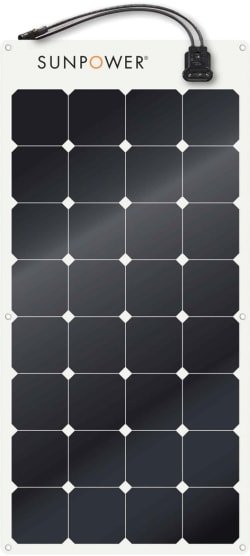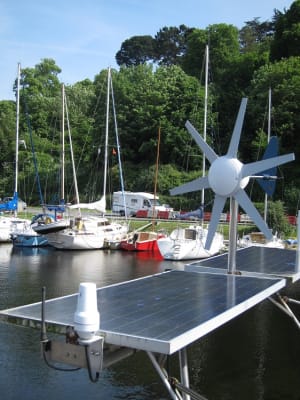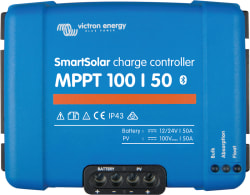Master Marine Solar Panels: The Basics and Beyond
Over the last decade, the cost of installing solar power on a boat has dropped substantially, the quality of solar panels has improved, and installation and monitoring have never been easier – making solar power a feasible option for many boaters. In this Navigator, we look at the benefits of installing a solar system on your boat, along with some of the things that you need to consider when sizing your panels and deciding how your installation should be set up.
Benefits of Solar Panels
If you spend a lot of time at anchor and can't stand the noise of running your engine or generator to top up the batteries, solar power may be just the clean energy you're looking for. Once installed, solar panels quietly convert sunlight into electrical current – putting amps into your batteries over the course of the day and replacing the amps you've used running the stereo or chilling that beverage – and they do this with almost zero interference, day after day for as long as you have them hooked up. Additionally, marine solar panels offer the added benefit of being able to be installed as a DIY project, giving boat owners the freedom to choose and install their own off-grid marine solar panels and accessories.
When sized correctly, your solar installation can give you complete energy independence. Because solar charging has a low amperage, it's a more efficient way to top up your batteries since the “float” cycle can take a ridiculously long time.
Best of all, it allows you to safely charge your batteries when you are away from the boat. So if you leave your boat on a mooring or choose not to plug in at the dock, you'll still have charged batteries when you return to the boat. If you normally pay for power at the dock, the savings can potentially add up!
 Solar Power Systems
Solar Power Systems
A basic solar power installation will consist of 3 things: the solar panel(s), a solar charge controller, and your battery bank. The solar panel(s) will be wired to the charge controller, and the controller will be wired to your batteries. While it's possible to wire the panels directly to the battery, we don't advise it due to the current's variability based on the sunlight hitting the panels. We highly recommend a solar charge controller to protect the batteries from receiving too much current during higher panel output.
At Fisheries Supply, we offer a variety of solar charge controllers, including options for lithium batteries. At their most basic – they will regulate the amount of current passing through to make sure the batteries are not overcharged. But like everything – solar controllers have evolved, and newer options, such as the popular Victron SmartSolar MPPT Solar Charge Controller, will not only maximize the harvesting of energy from your panels to achieve full charge in the shortest possible time – but it's also “smart” enough to maintain your batteries' health and extend their life by administering charge based on what charge state the batteries are in. Some controllers (including this one) even come with the ability to monitor (via Bluetooth) remotely what's happening during charging – whether you're on your boat or at work – giving you peace of mind that everything is working correctly.
Sizing your Panels
The amount of solar panels that you will need is determined by how many amps you would like to replace. Do you only want to offset the self-discharge rate of your battery bank and keep them topped up without plugging into shore power – or do you want them to replace the average amps used during a weekend on the hook? Once you've added up the number of amps you think you'll need – you will have a better idea of how many panels to install, taking into consideration the typical amp hours and volts used by your appliances.
While solar panels technically gather sunlight and produce energy all day long, it's generally accepted that, given good sunlight and minimal shading, they will produce their maximum stated power for five hours a day.
Keeping this in mind – let's figure out how many amps a panel will produce daily. Since most solar panels are rated in watts, we need to divide by 15 to determine the approximate output in amps. So, a 100-watt panel will produce a maximum output of approximately 6.67 amps. Taking our 5 hours of maximum power a day, that same 100-watt panel will produce a little over 33 amps a day (6.67 x 5). Therefore, if you think you need to replace 100 amps a day – you would need at least three 100-watt panels and strong solar to do it. Obviously, if all we want to do is offset the self-discharge of our battery bank, you would need far less power.
Panel Placement

Solar panels are also affected by heat – the hotter the panel gets, the less efficient it will be – so it's a good idea for your installation to allow airflow around the panel if possible.
Lastly, solar panels are highly affected by “shadowing” – that is, having part of their collective cells blocked by shade. For this reason, it's very important to consider items that will create shade throughout the day as the sun moves across the sky and your boat changes position at anchor. This might include a radome, the mast/spreaders, or even something as small as an antenna. While modern solar panels have become more efficient by using bypass diodes across each cell, they are still affected by shade, and having a shadow on just one cell of the panel could potentially reduce power by 20% or more – so consider placement carefully, especially when using flexible solar panels that can be mounted on canvas such as a bimini top.
Wiring in Series vs. Parallel
If you will be installing more than one panel, you'll also need to decide how you are going to wire them. Your two choices are wiring in series or in parallel. When wiring panels in series, the voltage is additive, and the current is constant – so you can use a smaller wire size over longer runs. Conversely, wiring panels in parallel means the voltage is constant while the current is additive – meaning you'll have higher currents traveling through the wire, and so will need larger gauge wire (which may be harder to run), and you may suffer loss over a long wire run. So why would you choose parallel? Since each panel functions separately, there is less of an issue with shading. If one panel is heavily shaded, but the other panel is not shaded at all – the non-shaded panel is still producing at maximum efficiency. If the panels are in series, one shaded panel will affect the output of ALL the panels, so if you can't avoid shading issues, you may want to consider wiring in parallel.
 Sizing your Solar Charge Controller
Sizing your Solar Charge Controller
Once you've figured out what size panel(s) you are going to buy, it's time to calculate what size solar charge controller you need. Most controllers are sized by the maximum voltage over current (Voc) – but given temperature variables, this number can be hard to calculate. Thankfully, Victron has developed a handy sizing calculator. To use it, you'll need some information that should be displayed on the back of your solar panels or in the specifications for your panel(s). One thing to remember when filling out the “PV Module Temperature” min/max is that you should use the coldest date on record for the regions you plan to cruise in. Since operating temperatures impact the controller and since Voc increases as temperature decreases, it's very important to know the coldest potential operating temperature so that the controller doesn't fail on that trip to Alaska. If there's any doubt, up size!
What is “Cell Efficiency” and Why Does it Matter?
The solar cell efficiency rating refers to the portion of sunlight that can be converted (via photovoltaics) into electricity. Current solar technology only converts electricity with a maximum efficiency of about 25%. As a rule, solid (frame) solar panels tend to have higher efficiency ratings than flexible panels (usually about 22% vs. 17%), but with advancements in solar technology – that is changing too. For example, our Sun Power line of flexible panels has achieved a rating of 22-25% - astounding for a flexible panel. The bottom line is that the higher the cell efficiency percentage, the more energy you can convert with your panel, which equals higher amps going into your batteries.
 Monocrystalline vs
Polycrystalline (Multi-Crystalline) Solar Cells
Monocrystalline vs
Polycrystalline (Multi-Crystalline) Solar Cells
While both Mono and Polycrystalline cells capture the sun, turn it into electricity, and are made from silicon – there is one key difference. When Monocrystalline cells are manufactured, silicon is formed into bars and cut into wafers. Because the cell is composed of a single crystal or ingot, the electrons that generate a flow of electricity have more room to move. With poly or multi-crystalline cells, there are many crystals in each cell, which means there is less room to move, which results in lower efficiency ratings. While polycrystalline cells are less expensive, their reduced efficiency often results in a less effective installation, which is an important factor to think about when considering the cost. As with most things in life – you get what you pay for.
Are there any specific maintenance requirements for marine solar panels?
Regularly clean marine solar panels to remove dust, dirt, and salt residue that can reduce efficiency. Check for any loose connections, ensure panels are securely mounted, and inspect for any signs of wear or damage. Routine maintenance helps maximize the lifespan and performance of marine solar panels.
Potential Tax Credit for Solar Installations
Thanks to the Bipartisan Budget Act of 2018, there is a tax credit for solar, wind, or fuel cell installations that may help you offset your set-up costs. It reads as follows:
A taxpayer may claim a credit of 30% of qualified expenditures for a system that serves a dwelling unit located in the United States that is owned and used as a residence by the taxpayer. Expenditures include labor costs for on-site preparation, assembly or original system installation, and for piping or wiring to interconnect a system to the home."
To get the credit, your boat will need to be considered a “2nd home.” For more information and to see if your installation would qualify, visit this website. Now for a word from our lawyer – this article does not constitute accounting, tax, or legal advice. This article has been prepared for informational purposes only. You should consult with your own accounting, tax, or legal advisors.
As you can see, there are many things to consider when deciding on a solar power installation for your boat, but we hope you've found this Navigator helpful. If you need more information, please don't hesitate to call our knowledgeable staff at (800) 426-6930.